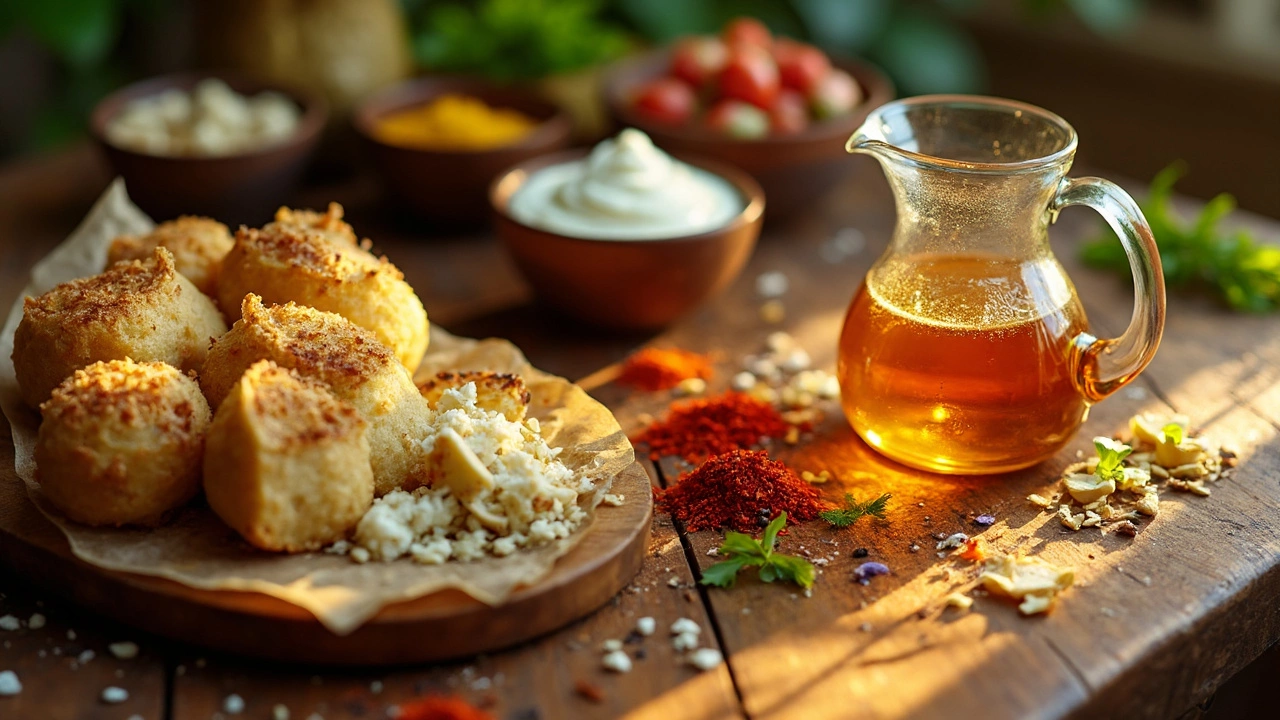So, you’ve been making homemade paneer and realized there's this watery stuff left over—whey. What do you do with it? Instead of pouring it down the drain, let’s talk about how this liquid can be surprisingly useful. It's like striking gold in your kitchen, but not the kind you want to just flush away.
This whey, basically the wastewater from your paneer adventure, is packed full of goodies. We're talking proteins, vitamins, and minerals that can enhance recipes or even spruce up your garden. Imagine giving your plants a little nutrient boost while minimizing waste. Sounds great, right?
No need to be a gourmet chef to make the most of it. From enhancing soups to baking fluffy bread, paneer whey is a game-changer. And if you're into sustainable living, it gets even better. Stick around to uncover how you can incorporate this often-neglected byproduct into your daily life, saving some cash and Mother Earth.
- What is Paneer Whey?
- Nutritional Value of Whey
- Creative Uses in Cooking
- Eco-Friendly Household Tips
- Storage and Preservation
What is Paneer Whey?
When you're making homemade paneer, you start by heating milk and adding an acid like lemon juice or vinegar to it. This process causes the milk to curdle, separating into curds and whey. The curds are what we know as paneer, and the whey is the leftover liquid.
This liquid might look a bit like cloudy water, but don't let its humble appearance fool you. Whey from homemade paneer is chock-full of nutrients. It's loaded with proteins, making it a great addition to your diet. The proteins are complete, meaning they contain all the essential amino acids your body needs.
A little-known fact is that whey also contains minerals like calcium and vitamins including B2 and B12. Actually, about 20% of the protein in milk stays in whey, along with nearly 50% of milk's nutrients, even after the curds have been separated.
| Nutrient | Percentage in Whey |
|---|---|
| Protein | 20% |
| Vitamins & Minerals | 50% |
Now, before you think of tossing it out, remember this: Paneer whey is super versatile. It can find its way into various recipes or be used as a nutritious drink or even a natural cleaning solution. Knowing what it is can help you save money and take a step into eco-friendly living with every block of paneer you make.
Nutritional Value of Whey
You might be wondering why paneer whey is worth your attention. It’s not just any old liquid; it's a little powerhouse loaded with nutrients. When you make paneer, the separation of curds and whey leaves behind a liquid that's rich in proteins, primarily lactalbumin, which is great news for muscle repair and growth.
Now, don't think of it as another boring leftover. This whey is full of calcium, which supports strong bones and teeth, and it’s also packed with B vitamins like B2 and B12 that are essential for energy production and nervous system health.
For those of you counting calories or looking to add a nutrient boost to your meals, whey is a low-fat option. Plus, it's a decent source of potassium, magnesium, and phosphorus, all of which play crucial roles in maintaining cellular function and bone health.
If you're interested in numbers, here's a simple breakdown:
| Nutrient | Content per 100g |
|---|---|
| Protein | 0.8g |
| Calcium | 44mg |
| Potassium | 44mg |
| Vitamin B2 | 0.1mg |
| Calories | 26 kcal |
So, before you toss that wastewater of paneer down the drain, think about the nutrients you’re rinsing away! Whether you sip it as a post-workout shake, use it in cooking to enhance flavors, or even apply it in skincare treatments, this humble whey is truly a multifunctional marvel.

Creative Uses in Cooking
Alright, you’ve got this paneer whey hanging around and you’re thinking, ‘What now?’ Hold tight because it’s not just for plants or pets—it’s time to unleash it in your cooking adventures!
First off, let's chat about baking. Whey makes a terrific substitute for water or milk in bread recipes. The end result? Super soft and tasty bread. Just swap it in and see if your loaf doesn’t get all the love at the dinner table. Trust me, your sandwich will thank you.
Don’t stop there. Soups and stews benefit big time from whey’s rich, slightly tangy flavor. Next time you’re simmering something hearty, pop some whey in to replace part of the broth or water. Notice how it boosts the flavor without extra fat or sodium.
Missing your morning pancakes or waffles being just right? Use whey instead of milk. This nifty tweak adds a subtle tang and enriches your breakfast classics with added nutrients. Plus, they brown beautifully!
- Marinate Meats: Marinating chicken or pork in whey can make it extra tender. Just mix with your favorite herbs and spices.
- Pasta Perfection: Boiling pasta in whey? Sounds unusual, but give it a go and you’ll be amazed at the enhanced flavor.
- Beverage Booster: Mix whey in your next smoothie for an unexpected protein boost. Your post-workout drink just got an upgrade.
Honestly, the world is your culinary oyster when it comes to using whey. Why let the good stuff go to waste when it can elevate your cooking game? Next time you're whipping up some homemade paneer, get creative with its leftover magic. Not only will you cut down on waste, but you’ll add a little something special to your dishes!
Eco-Friendly Household Tips
So, you've got yourself a good amount of wastewater of paneer and you're wondering how to use it beyond the kitchen. Well, this paneer byproduct can actually lend a hand in various eco-friendly ways around your home.
Let's kick off with using it as a plant food. Paneer whey is packed with minerals, making it a nifty fertilizer for your plants. Simply use a 1:1 mix of whey and water to give your indoor plants a nutrient-rich drink. Garden plants will love it too, just make sure to dilute it to prevent any unintended side effects on soil pH.
Cleaning might not be the first thing you think of, but whey can do wonders here. It's slightly acidic, which means it can tackle limescale and soap scum. Use it to clean your sinks or, as some folks swear by, for a natural shine on bathroom tiles. Just apply some whey, let it sit for a bit, and wipe clean.
If you’re into composting, paneer whey can speed up the process. Pour a little into your compost for a natural booster. This acidic touch activates composting microbes, helping break down materials faster and making nutrient-rich compost for your garden.
- Pest Control: Use diluted whey as a deterrent for some pests in your garden.
- Pet Care: Dilute it further and see if your pets tolerate a small amount in their water—it’s often safe and nutritious for them.
- DIY Air Freshener: Mix whey with essential oils and water in a spray bottle for a natural air freshener.
It's all about saving the planet, one whey drip at a time. Think of paneer whey as more than just a byproduct—it’s your secret weapon in turning your household a shade greener.

Storage and Preservation
Keeping your paneer whey fresh and ready to use is easier than you might think. First things first, make sure you store it in a clean, airtight container. A glass jar with a tight lid or a plastic container with a good seal works just fine.
In the fridge, whey stays in good condition for up to a week. That gives you enough time to use it up before it goes bad. If you’re not diving into it right away, freezing is a fantastic option. Just pour the whey into ice cube trays, freeze them, and then pop the cubes into a freezer bag. This way, you’ve got convenient little portions ready to go whenever your recipe calls for it.
Oh, and here’s a neat trick if you want to store a larger quantity: use zip-lock bags. Lay them flat in the freezer. This way, you save space, and they thaw out quicker when you need them.
While preserving whey, remember not to let it sit out at room temperature for too long, as it can spoil easily. Having a little game plan for using your whey can save you some trial and error, not to mention keep your creations tasty and fresh.
And if you're worried about the freezer getting crowded, make a mental note that using it in the garden doesn't require pristine freshness. There, a little past its prime won't hurt anyone.
